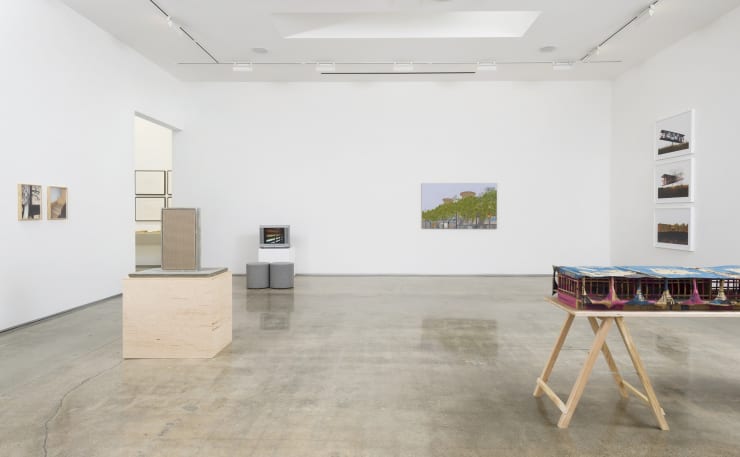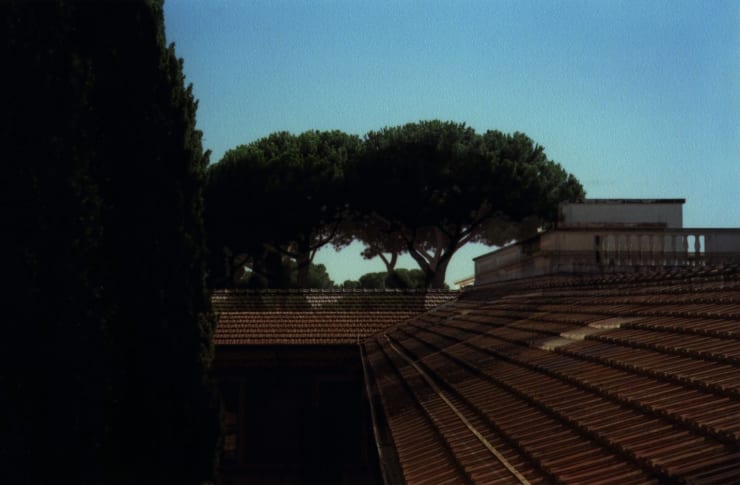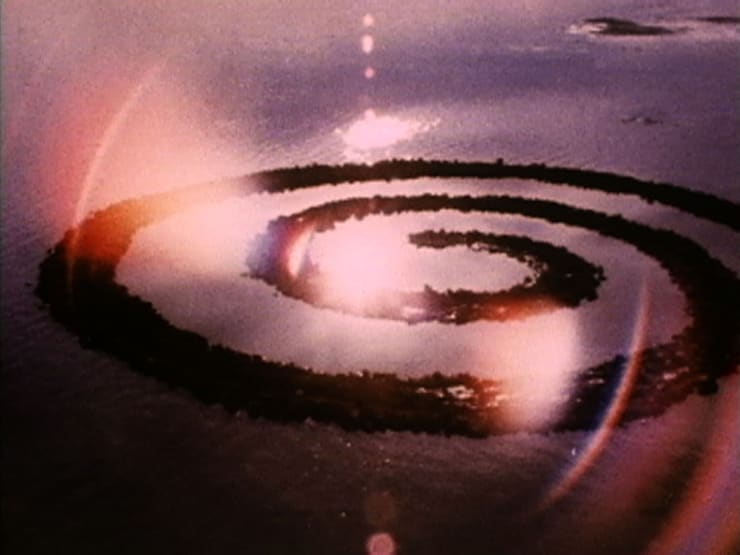Vernacular Environments, Part 1
Edward Cella Art & Architecture presents Vernacular Environments, Part 1, a group exhibition of works selected from the 1960s through present day that explore the diversity of tensions between built environments, bodies, and narratives. Vernacular Environments, Part 1 is the first of an annual exhibition that asks, what pluralities do you live in? Through varied typologies, the works included in this exhibition present a range of responses to environments and dispute the purity of space while signaling cultural identification through representations of figures, structures, and concepts.
Among the artists featured in this exhibition are Stephen Berens, Jennifer Bolande, Raúl Cordero, William Leavitt, John Mason, Alex Schweder, Robert Smithson, Clarissa Tossin, and MICA-TV (Michael Owen/Carole Ann Klonarides) in collaboration with Dike Blair, Dan Graham, and Christian Marclay.
Edward Cella Art & Architecture presents Vernacular Environments, Part 1, a group exhibition of works selected from the 1960s through present day that explore the diversity of tensions between built environments, bodies, and narratives. Vernacular Environments, Part 1 is the first of an annual exhibition that asks, what pluralities do you live in? Through varied typologies, the works included in this exhibition present a range of responses to environments and dispute the purity of space while signaling cultural identification through representations of figures, structures, and concepts.
Among the artists featured in this exhibition are Stephen Berens, Jennifer Bolande, Raúl Cordero, William Leavitt, John Mason, Alex Schweder, Robert Smithson, Clarissa Tossin, and MICA-TV (Michael Owen/Carole Ann Klonarides) in collaboration with Dike Blair, Dan Graham, and Christian Marclay. While artists like Berens, Bolande, Leavitt, Mason, Smithson, Tossin, and MICA-TV are well-known and acclaimed on the West Coast and abroad, Vernacular Environments, Part 1 offers a dynamic opportunity to introduce New York based Schweder and Mexico City based Cordero to a West Coast audience and position them within a broader artistic and conceptual dialogue.
Setting the tone for the series of Vernacular Environments exhibitions is Robert Smithson’s film Spiral Jetty (1970). The film Spiral Jetty is a “portrait” of his monumental earthwork of the same name, created in April of 1970 and permanently situated at Rozel Point in the Great Salt Lake, Utah. Comprised of basalt rocks, mud, and salt crystals, Smithson’s 1500 x 15-foot artwork juts out from the lake’s shore and coils dramatically into luminous red water. The film documents the making of this earthwork, which has attained near mythical status as it has disappeared and then re-emerged from the lake over the past decades.
Just as Smithson’s film, photoworks, and drawings are all conceptually integral to the totality of Spiral Jetty, John Mason’s 1978 drawings operate like architectural blueprints for his firebrick sculptures. In stark contrast to the expressive clay works which gained acclaim in the late 1960s, these drawings intersect mathematical relationships and geometric descriptions for minimalist sculptures that were meant to be both examined and experienced. Where Smithson’s built environments were comprised of found rocks and mud, Mason’s commercially fabricated firebrick sculptures and accompanied drawings eradicated any trace of the artist’s hand and allowed Mason to actualize simple plans of symmetry, translation, rotation, and reflection.
Integrating humor with specific visual and aural deconstructions, MICA-TV’s (Michael Owen/Carole Ann Klonarides) collaboration with artists Dike Blair, Dan Graham, and artist/composer Christian Marclay, crafts an ironic ode to the urban and suburban architecture of the contemporary American cultural landscape. Visually breathtaking, CASCADE/Vertical Landscapes (1988) is constructed as a continuous parade of vertical camera movements and image layering. MICA-TV borrows “found” sound and images from pop culture to trigger associations and memories. Consumer products and junk food fall like pop cultural debris through a vertical corridor of postwar cathedrals—shopping malls and urban arcades. Structured as a continuous flow of verticality, seamlessly edited and scored, this witty display both critiques and celebrates the contemporary American landscape as inscribed upon the collective unconscious.
Operating between the line of reality, fantasy and illusion is William Leavitt’s painting Skyline S.F. (2009) an ostensibly simple narrative painting depicting the city’s skyline in afternoon light. Characterizing California’s urban landscape, Leavitt exposes the narrative potential of our highly syncretic built environment and its tentative relationship to the natural world. Both fantastically strange and supernatural, Skyline S.F. calls attention to the theatricality of urban space. His practice which includes a wide range of activities such as installation, photography, painting, drawing, film, theatrical production, and music addresses architectural vernacular and the patterns of living it impresses upon its inhabitants.
At the intersection of memory and image are Raúl Cordero’s whimsically self-referential conceptual paintings which oscillate between forms of communication: words and images, cinema and video, documentary and narrative, imaginary and realistic. His large oil painting FR (II) (2013) portrays an out of focus aerial view of a theater proscenium with the letter “F" embedded into the theater curtains and the letter “R” on the audience. “FR” refers to the text at the bottom of the painting, an anecdote which describes Cordero’s dedication of an “ugly painting” to his late uncle Famin Rubiales. Upon his art dealer's donation of the painting to an “important museum," Cordero consequently receives endless commission requests for similar “ugly paintings”. Cordero’s interest is in when exactly an artwork begins and the constant interchange of people’s positions as they move between here and there, as if it were a memory.
Depicting the landscape from one precise viewpoint during a residency at the American Academy in Rome, Stephen Berens’ layered photographs connect the romanticism of landscape photography with critical artistic process. Originally exhibited at the 2014 Whitney Biennial, Berens’ All days are nights (2013-2014) were made out of a previous project entitled 40 Views of Rome (2005). For All days are nights the artist printed photographs on top of one another in a sequential manner. As the series progresses, details in the sky are the last to remain clearly visible and as the layers continue to build the image begins to appear virtually monochromatic. Yet, even in the darkest print (where eighteen images are stacked on top of one another), the basic elements of the landscape are visible, ghost-like in the blackness, a faint memory of its original image. This project represents two major themes in Berens’ practice: the revisitation of previous work as raw material for new work, and an exploration of how working within a generative system can produce unexpected and evocative results.
A sequence of photographs and a sculpture will be exhibited by Jennifer Bolande. Whereas Berens’ process reveals the illusion of photography manifested in a physical photographic object, Bolande collapses objects into images and creates photographs that resist the medium’s flatness. Her sculptures and photographs call attention to the absurd while upending hierarchies and democratizing objects within their own context. Works such as Model for a Performing Arts Center (2017) a seemingly simple medium format photograph of a cardboard box demonstrates the range of Bolande’s constructed logic, and humor gives way to associative swapping. Her medium format sculpture entitled UN Speaker (2002) is based on the United Nations’ Manhattan headquarters and faced with Fender amplifier fabric, while the reverse has an actual photograph of the building’s façade, transforming this unpretentious amplifier into a monument.
Intervening in physical space is what artist Alex Schweder defines as “Performance Architecture,” a process through which he works with everyday domestic actions to transform the ways spaces are used. His ongoing project entitled SOAP (Schweder Office of Architectural Performances) is an experimental architectural office that offers performative renovations of domestic spaces, where little or nothing about the space is altered physically. Offering five one-on-one consultations, Schweder will meet with participants to design performances that, when enacted at home, change the ways that occupants perceive their spaces. Two unique, collaborative commissions will also be available, resulting in an instructional painted photograph depicting Schweder dressed as his collaborator enacting the first iteration of the performance within the participant’s space. Schweder will also exhibit photographs and drawings that interpret his ReActor (2016), a 40-foot modernist structure installed at Omi International Arts Center in Ghent, NY that spins and tilts with the wind and weight of its inhabitants.
Taking location into account and conceived as an altered site-specific installation is Monument to Sacolândia (2010) by Clarissa Tossin. This representational sculpture of the Palácio da Alvorada—the first Oscar Niemeyer building and official residence of Brazil’s president—resembles the scale of an architectural model and is made entirely from empty cement bags. Sacolândia, or Bagland, was the popular name given to an informal settlement of shacks constructed from leftover cement bags, populated by laborers during the city’s construction. It was located in the depression that was flooded to become Paranoá Lake, its inhabitants relocated to the outskirts of the planned city. A video documents the sculpture being set afloat atop a Styrofoam base on Paranoá Lake with the palace’s gardens as its backdrop. Drawing attention to the irony of a “postcard image” of the city, a stack of postcards are free for taking. This work offers a critical intervention that also resembles child’s play by sending a drifting building around a lake.
EXHIBITION PROGRAMS
Architectural Advice for Performative Renovations by SOAP
(Schweder Office of Architectural Performances)
Reserve a one-on-one consultation with Alex Schweder to collaboratively design a “performative renovation” of your home. Alter your domestic actions to transform your perception of physical space. Initial conversations are free, but can be taken further to commission a unique, instructional painted photograph. Sessions are limited; please contact the gallery for reservations
In Conversation: Joseph Becker, Miki Garcia, and Carole Ann Klonarides
Saturday, June 3, 4 p.m.
Please join us for a roundtable discussion with Joseph Becker (Associate Curator at SFMOMA), Miki Garcia (Executive Director at MCASB), and Carole Ann Klonarides (independent curator), offering their perspectives on artists’ engagement with architecture and the built environment.
Joseph Becker is the Associate Curator of Architecture and Design at the San Francisco Museum of Modern Art. He received his Bachelor of Architecture and his Masters of Advanced Architectural Design in Design Theory and Critical Practice from the California College of the Arts. Since 2007, Joseph has contributed to over twenty exhibitions at SFMOMA, including Tomás Saraceno: Stillness in Motion – Cloud Cities (2016-7) and Lebbeus Woods, Architect (2013-14). In addition, he has been responsible for many major acquisitions for SFMOMA’s collection as well as the exhibition design and visual direction of the majority of SFMOMA’s A+D exhibitions during his decade-long tenure.
Miki Garcia was appointed Executive Director and Chief Curator of the Museum of Contemporary Art Santa Barbara in January 2005. Prior to this, she worked at the Public Art Fund, N.Y. from 2001 to 2004. From 1999 to 2001 Garcia was a Curatorial Associate at the Museum of Contemporary Art, San Diego and has also worked at the Blanton Museum of Art at the University of Texas and the San Antonio Museum of Art. Garcia holds a BA from Vassar College, Poughkeepsie, NY and a MA in Latin American art from the University of Austin, Texas.
Carole Ann Klonarides is known primarily for her pioneering artistic and curatorial work in video art, particularly in relation to the historic art scenes in downtown New York (1972–91) and Los Angeles (1991–present). Since 2010, she has served as a career strategist for artists and management consultant for galleries and arts organizations in Los Angeles. In addition to having curated many exhibitions for non-profit art organizations, galleries and museums, Klonarides' own video work has been presented in numerous museum exhibitions.
-
 Alex Schweder, Reactor, Time Lapse (with Ward Shelley), 2017
Alex Schweder, Reactor, Time Lapse (with Ward Shelley), 2017 -
 Alex Schweder, Ward Shelley and photograph by Richard BarnesReactor, Ward Tilting, 2016
Alex Schweder, Ward Shelley and photograph by Richard BarnesReactor, Ward Tilting, 2016 -
 Alex Schweder, Reactor Shadow (with Ward Shelley), 2017
Alex Schweder, Reactor Shadow (with Ward Shelley), 2017 -
 Alex Schweder, Counterweight Roommate, 2017
Alex Schweder, Counterweight Roommate, 2017 -
 Alex Schweder, Architectural Advice for Performative Renovations by SOAP (Schweder Office of Architectural Performances), Ongoing performances since 2009
Alex Schweder, Architectural Advice for Performative Renovations by SOAP (Schweder Office of Architectural Performances), Ongoing performances since 2009 -
 Stephen Berens, July 31, 2005, AfternoonJuly 19, 2005, Morning, 2013
Stephen Berens, July 31, 2005, AfternoonJuly 19, 2005, Morning, 2013 -
 Stephen Berens, July 31, 2005, AfternoonJuly 19, 2005, MorningAugust 8, 2005, MorningJuly 29, 2005, Late Afternoon, 2013
Stephen Berens, July 31, 2005, AfternoonJuly 19, 2005, MorningAugust 8, 2005, MorningJuly 29, 2005, Late Afternoon, 2013 -
 Stephen Berens, July 31, 2005, AfternoonJuly 19, 2005, MorningAugust 8, 2005, MorningJuly 29, 2005, Late AfternoonJuly 25, 2005, Late EveningAugust 7, 2005, MorningJuly 26, 2005, MorningAugust 3, 2005, Late AfternoonAugust 8, 2005, MorningAugust 3, 2005, Afternoon, 2013
Stephen Berens, July 31, 2005, AfternoonJuly 19, 2005, MorningAugust 8, 2005, MorningJuly 29, 2005, Late AfternoonJuly 25, 2005, Late EveningAugust 7, 2005, MorningJuly 26, 2005, MorningAugust 3, 2005, Late AfternoonAugust 8, 2005, MorningAugust 3, 2005, Afternoon, 2013 -
 Stephen Berens, August 4, 2005, NightJuly 28, 2005, Night (Lightning)July 28, 2005, NightAugust 7, 2005, NightJuly 29, 2005, Middle of the NightAugust 5, 2005, NightAugust 3, 2005, Early Morning (Rain & Fog), 2013
Stephen Berens, August 4, 2005, NightJuly 28, 2005, Night (Lightning)July 28, 2005, NightAugust 7, 2005, NightJuly 29, 2005, Middle of the NightAugust 5, 2005, NightAugust 3, 2005, Early Morning (Rain & Fog), 2013 -
 Stephen Berens, August 4, 2005, NightJuly 28, 2005, Night (Lightning), 2013
Stephen Berens, August 4, 2005, NightJuly 28, 2005, Night (Lightning), 2013 -
 Robert Smithson, Spiral Jetty, 1970
Robert Smithson, Spiral Jetty, 1970 -
 Raúl Cordero, FR (II), 2013
Raúl Cordero, FR (II), 2013 -
 Jennifer Bolande, UN Speaker, 2002
Jennifer Bolande, UN Speaker, 2002 -
 Jennifer Bolande, Exposed Concrete, Ed. 2/6, 2015
Jennifer Bolande, Exposed Concrete, Ed. 2/6, 2015 -
 Jennifer Bolande, Model for a Performing Arts Center, Edition 2 of 6, 2015
Jennifer Bolande, Model for a Performing Arts Center, Edition 2 of 6, 2015 -
 and Christian Marclay MICA-TV (Michael Owen/Carole Ann Klonarides) in collaboration with Dike Blair Dan Graham, CASCADE/Vertical Landscapes, 1988
and Christian Marclay MICA-TV (Michael Owen/Carole Ann Klonarides) in collaboration with Dike Blair Dan Graham, CASCADE/Vertical Landscapes, 1988 -
 William Leavitt, Skyline S.F., 2009
William Leavitt, Skyline S.F., 2009 -
 Clarissa Tossin, Monument to Sacolândia, 2010
Clarissa Tossin, Monument to Sacolândia, 2010
-
Architecture catches the acting bug
Christopher Hawthorne, Los Angeles Times, Jun 29, 2017 -
Review: Vernacular Environments, Part 1
James Daichendt, ArtScene, Jun 28, 2017 This link opens in a new tab. -
Review: Vernacular Environments, Part 1
Isa Safari, Artillery, Jun 28, 2017 This link opens in a new tab.































